23 Actionable Tips for a Winning Sales Pitch [With Examples]
![23 Actionable Tips for a Winning Sales Pitch [With Examples]](https://webimages.zixflow.com/656db010e7aa287d56de9382_Winning_20_Sales_20_Pitch_2f4b9258d5.png)
Consider a scenario where you are standing in a room full of prospects and are going to present your pitch about your company’s offerings. Even though you are presenting a sales pitch, it acts as a bridge between prospects and satisfied customers.
This scenario showcases the importance of a solid sales pitch and how easy it is for you to get new leads or convert the already engaging ones.
A sales pitch is a critical component you have to take into account when implementing a sales engagement process. It represents your business, offerings, and your unique story that makes you stand apart from the competition.
Now a question arises, how can you create an effective sales pitch to turn curious prospects into enthusiastic customers?
To answer that question, in this article, I will go over what a sales pitch is, its importance, and 23 practical tips you can use to craft a successful sales pitch. So, let us get into it!
What is a sales pitch?
A sales pitch is an approach that your sales representative uses to persuade a prospect to purchase your product or service. It is a brief presentation that usually involves the advantages your product offers and the problems it can solve.
A sales pitch is typically also called an elevator pitch as it is only a couple of minutes long and can be presented to your target audience in the time it takes to complete an elevator ride.
A solid and well-structured sales pitch can help you interact with your potential customers, establish rapport, and finally result in a conversion.
Tips on how to craft a sales pitch
A sales pitch can allow you to get your business’s unique selling point across your prospects quickly. So, you have to ensure that your sales pitch is well-crafted and contains only the most important information. With that in mind, here are the tips you should follow when creating your sales pitch from the ground up:
Know who you’re pitching to
“Before you make your sales pitch, find what the person can gain from the deal going forward.”
Sales pitches are not long or comprehensive. They are short and to the point. So, if you don’t know who you are pitching to, you are most likely wasting your time.
Also, understanding your audience allows you to tailor your pitch according to their needs, further increasing your chances of success.
For example, if you’re marketing a tool for the IT industry, you should focus more on its advanced capabilities. On the other hand, if your product is suitable for a general audience, highlight its user-friendliness.
Furthermore, if you target key decision-makers, you might be able to skip the initial stages of the sales pipeline. So, it is critical that you understand your audience first before creating your pitch.
One way to do this is to create ideal customer profiles (ICPs) that contain all the necessary information about your target market. You can create separate ICPs for different segments in your target audience and tailor your pitch accordingly.
Address pain points
An aspect you have to keep in mind when crafting a sales pitch is that your pitch should resolve the pain points your prospects are facing. Your pitch might fall short if you focus too much on making a sale instead of solving an issue.
Before you consider addressing your prospects’ pain points, you first need to identify them. One of the easiest ways to accomplish this is to ask your prospects directly. Asking your prospects to participate in a survey or by asking the correct sales engagement questions, you can get a lot of details about your leads.
Airbnb, a global hospitality and lodging company, uses surveys sent via email to ask its users about their recent lodging experience. It sends these surveys once the customer has finished their trip to ensure that they can provide accurate information.
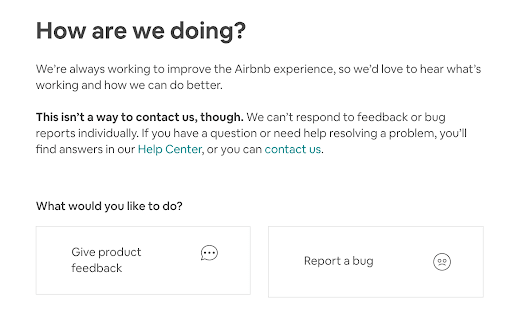
Personalize your pitch
Imagine that you got an offer from a company giving you a whopping 80% off on its products for a whole year but that product is not suitable or relevant to you. Would you still think about buying that product even if it was so heavily discounted? Most likely, no.
The same is the case with your prospects. If you pitch offerings to your prospects that are not relevant or tailored to their needs, they will not think twice about making a purchase.
So, ensure that not only your sales pitch but all of your conversations are personalized according to your prospects. For example, sending tailored emails has become a norm nowadays, and creating personalized emails for every prospect is a time-consuming task.
For this reason, Zixflow AI Wizard generates a highly personalized email just on the basic information you have filled in. The Wizard also allows you to save this email as a template that you can edit and send as many times as you want.
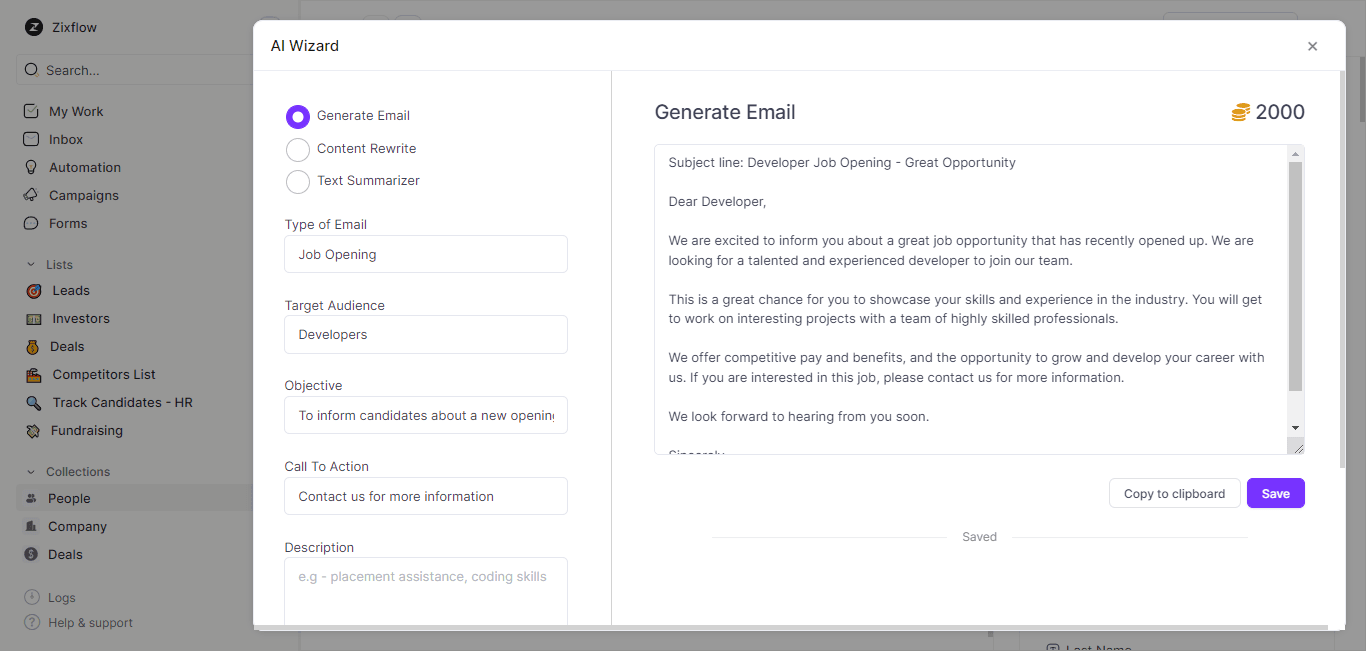
Start with a hook
Sales pitches are not long demonstrations. You can’t use them to tell your prospects about every feature of your product. Also, you have to grab the attention of your audience fast, as many will lose interest if they don’t see the benefits.
To do that, you need to begin your sales pitch with an interesting hook to foster customer engagement to increase sales. By hook, I mean a compelling statement, statistic, question, or fact. For instance, your hook can be like,
“Our customers have boosted their sales and revenue by 41% in the first five months of using our offerings. And you can get the same outcome?”
Offer value at the beginning
An extension of the previous tip, right after you get the attention of your prospects, you have to offer what values your product or service provides.
For this, you can adopt a value-based selling approach. When starting your sales pitch, highlight key advantages straight away. For example, if you have a sales automation tool, you can say,
“Our product will save you money and time by automating redundant tasks in your sales process.”
Adopt a customer-centric approach
Having a customer-centric selling approach allows you to focus on building connections with your prospects. With a sales pitch revolving around your customers, you can build credibility and appear as a trustful advisor rather than a salesperson.
One way to do this is to structure your sales pitch in a way that concentrates on solving issues faced by your prospects and not getting a sale. You have to showcase how your solutions can address their problems and make their life easier. This can be done by taking consumer-centric approaches like consultative type of selling, solution selling, etc.
Ask questions
Prior to presenting your sales pitch to your prospects, you might’ve gotten a chance to talk with your lead to get an idea of their pain points and what they are expecting to get from your solutions. This is the time to ask proper sales qualifying questions to see how your offerings best fit their needs.
These questions allow you to get in-depth knowledge about your prospects that you might have missed in your initial research. Also, by asking valid questions, your prospect sees that you’re genuinely interested in resolving their issues and not just making a quick sale.
Use facts and data
Another important aspect of creating your sales pitch is to showcase hard facts or numbers to instill confidence in prospects that you are an expert in your field and have the ability to back up what you're saying.
This is particularly the case for new customers as they are not aware of your company or your product. So, in order to convince your prospects that your offer is beneficial, make sure that you do comprehensive market research to highlight major industry trends and how your products adapt accordingly.
Lastly, it is necessary to be to your prospects regarding your offerings. By being honest and not hiding the shortcomings of your product, you will be able to build trustful relationships to get more sales and repeat purchases.
Incorporate graphics
If you are delivering your sales pitch at a meeting or an event, adding visual elements to it can greatly increase its effectiveness. In fact, 40% of individuals absorb details better via images than from plain text.
On top of that, your sales pitch becomes more interactive and engaging when you show your audience the benefits of your products rather than telling them. You can also incorporate videos into your sales pitch to further drive home a point or a particular benefit. Consider leveraging product video production to effectively create a video that will help you achieve your desired impact.
For example, UpstartWorks, an IT Solutions and logistics company, uses graphical, animated slides in its sales pitch to share its solutions with its audience.
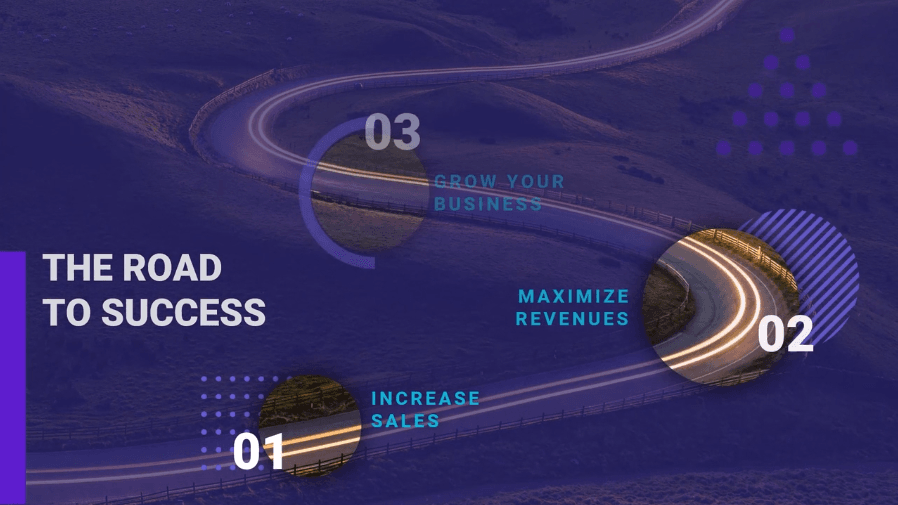
Use power words
Power words are persuasive words that evoke emotional responses and generate a sense of urgency to encourage your prospects to make a decision. When used correctly, these words have a strong impact on your audience.
For example, power words like “Best,” “Exclusive,” and “Limited” are the most used power words you will hear in a sales pitch or discount offers. The reason is these words create urgency while highlighting the quality of the product or service. They compel your audience to take action quickly.
Furthermore, power words like “You,” “Because,” “Limited,” and “Proven” are used to build connections and better engage your audience.
But, keep in mind that when using power words, moderation is the key. If you use too many power words in your sales pitch, you might sound overconfident or your sales pitch might come across as fake, focusing only on conversions.
Do you want to use an AI-powered salesOS to generate more leads?
Get started with Zixflow for free and see how it helps you boost your number of leads
Contact SalesProvide social proof
Social proof serves as a benchmark for your company to which your prospects can measure your past performance and see how you keep the promises you made.
Plus, social proof allows your prospects to understand how your solutions have helped your past customers who had similar problems. Also, seeing your past customers resolve their issues after using your offerings builds credibility for your business.
So, to showcase how your products or services have addressed the concerns of your previous customers, you should share customer success stories and reviews to fact-check the points mentioned in your sales pitch.
For instance, Fitbit built a section on its website to showcase the reviews and press mentions its products have gotten. This way, potential customers can quickly see the credibility of the company.
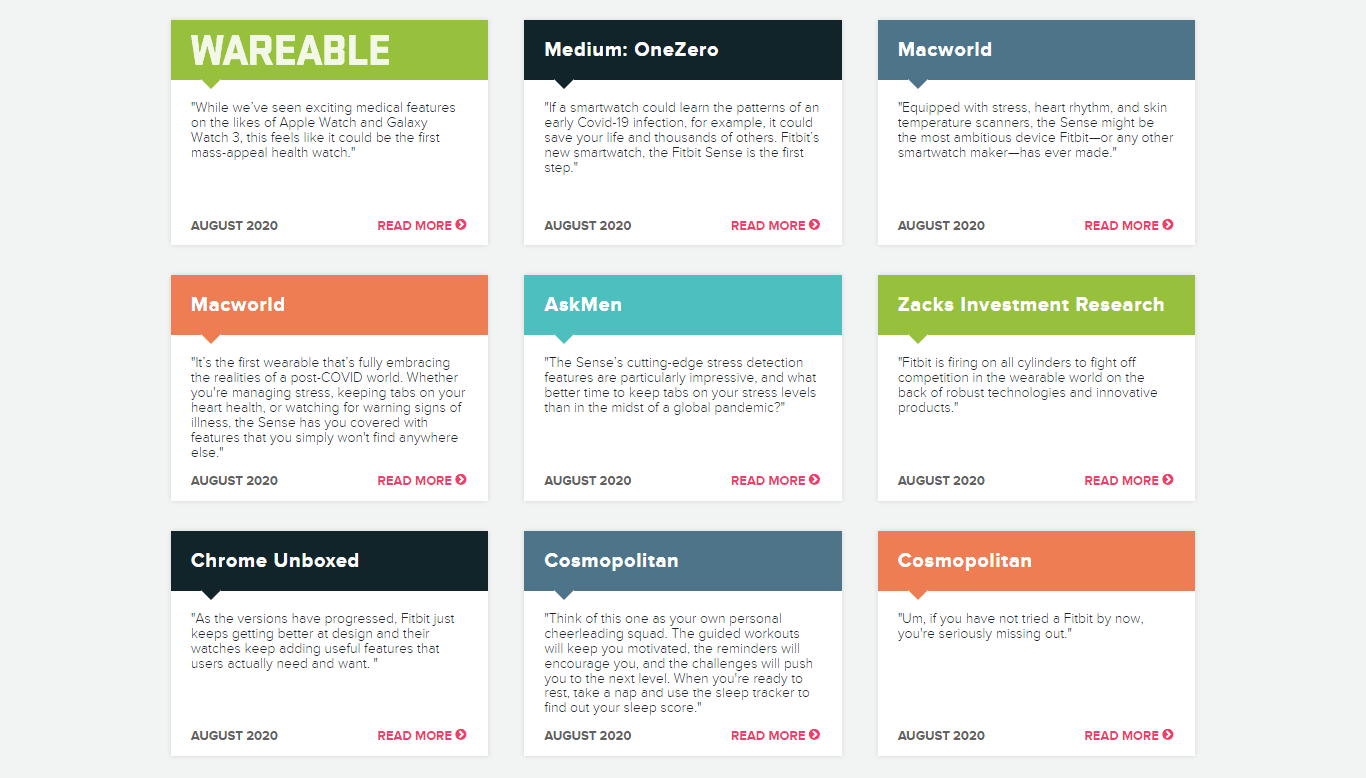
Sharing examples of happy buyers lets your potential customers see themselves getting similar benefits as them.
Avoid hard-selling techniques
Although the end goal of your sales pitch is to get a sale, you wouldn’t want to appear pushy in your approach. This kind of approach can alienate prospects.
Instead, you should focus on offering valuable and relevant solutions that help in solving problems. Adopt a sales engagement model that will let you make your prospect the hero and center of attention of your sales pitch.
Demonstrate your expertise
Understanding your product and industry know-how is crucial for creating a perfect sales pitch. Showcasing these qualities can be an excellent method to build relationships and drive home the aspect that you have in-depth knowledge of their pain points.
To accomplish this, know your product inside-out. Get in touch with your developers and thoroughly understand every function, advantage, and use case. Use this information when presenting your sales pitch and answering any questions that might come your way.
For instance, if your product is capable of handling different aspects of a process, emphasize the ones most relevant to a specific prospect’s pain point or requirements.
In case you are offering a service, clearly describe how it is beneficial to a prospect and how it stands out from the competition. This way, you can prove yourself as an expert and a thought leader in the industry.
Handle objections
Handling common sales objections and answering any questions asked by your prospects is a critical aspect of the sales process.
This is once again your chance to demonstrate your knowledge about your product and its pain points. This also allows you to portray yourself as an advisor that your prospects can look at and trust.
There are various ways to handle objections. Some of these are given below:
- Clearly describe how your offerings can resolve prospects’ issues effectively.
- Provide some kind of assurance so the prospects have a reason to trust you. This can include a 15-day refund policy, where the customers get a 100% refund if they don’t like your product or service.
- Offer special deals like exclusive discounts or limited-time offers.
Another quick tip to keep in mind is, that if you let your potential customers ask questions before you deliver your sales pitch, you might let go of your advantage as a speaker. This situation can also result in you being in a Q&A session instead of pitching your product.
To avoid this scenario, ensure that you answer common objections during your sales pitch or keep the questions part after you are finished pitching your sales pitch. This way, you keep control of the conversation and get all the important points across first.
Listen actively
One more tip you can use when you are pitching your sales pitch is to pay attention to what your audience is saying to you.
Many times, sales reps focus too much on crafting and delivering a perfect sales pitch that they forget to listen to the opinions or questions of their audience. This can downgrade your reputation as someone who only cares about his or her own views. And you definitely do not want that to happen.
So, listen to what your audience has to say after you are done with your sales pitch.
Active listening is a skill that will make your life easier as you can get comprehensive knowledge about your audience firsthand. This way, you can boost your chances of accomplishing your goal and guarantee quality customer satisfaction.
Keep it concise
Remember, a sales pitch needs to be concise and straightforward. You are not delivering a speech but trying to market your offerings. So, your audience might not be interested in extra details about your business.
For this reason, concentrate on your prospects’ concerns, how your product can solve those problems, and the key details your prospect requires to make a well-informed decision. Also, ensure that you use a conversational tone and stay away from technical jargon unless you’re pitching to a tech-savvy audience.
An excellent sales pitch is usually more effective than a lengthy one. Keep in mind that your objective is to create a great image of your offerings or business. So, pay attention to how to deliver the most value in the least number of words instead.
Matt Macnamara from Formcraft, for instance, showcases that you only need one minute to grab your leads’ attention. In the following one-minute sales pitch, he explains clearly about his business and how they can handle various problems for corporate tenants in the Philadelphia area.
Employ FOMO (sparingly)
FOMO or Fear of Missing Out is one of the sales engagement strategies, where you encourage your prospects to take quick action, usually making a purchase, by providing highly discounted prices.
Even though a sales pitch is different from a sale, the final objective is the same; Get a purchase. So, in your sales pitch, you can make use of the FOMO approach at the end to get your prospects to perform a task quickly.
For example, at the end of your presentation, you can encourage the audience to test out your product for free for the next 15 days or give a 50% discount to prospects who make a purchase after hearing your sales pitch.
Mangoola, for example, is an SEO suite that offers exclusive Black Friday deals using emails. The email content is short and to the point, providing the required information quickly.
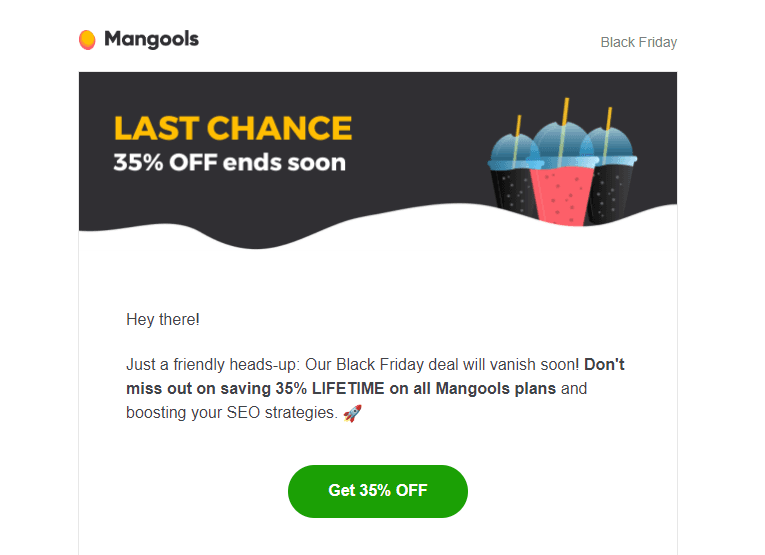
Explain ROI and costs
In the final phases of your sales pitch, you should explain what the ROI would be for your prospects if they make a purchase. Explain straightforwardly, what the price of your product or service is and whether you offer a one-time purchase or is it a recurring monthly subscription.
Give a clear picture of your pricing structure and all the extra expenses your prospects have to pay if they decide to choose your offerings. Be transparent and don’t hide expenditures that might cause problems later down the road.
Tell the next steps
Once you have handled every objection or query your prospects have regarding your solutions, the next stage is to explain the steps they have to take or decide on further communication if they are still unsure.
Waiting for them to consider your pitch and reach out to you doesn’t count as planning your next steps. This is because your prospects might not remember about you or your pitch and every day you wait to hear from them you decrease the chances of getting a conversion.
This is why you have to create a detailed checklist of the tasks you have to do to simplify your sales process and guide your prospects effectively.
For instance, a good method to motivate your lead to make a decision quickly is to emphasize the fact that not making a decision promptly can be disadvantageous for them.
Follow up with your prospect
After you have delivered your sales pitch, it is crucial to follow up with your prospects. In fact, 60% of buyers turn down the deals four times before thinking about buying a product. And 92% of sales reps tag the lead as lost after hearing no four times.
Not just that. Following up with your prospects demonstrates that you care about their needs and keep your pitch fresh in their minds. Below are a few ways to follow up with your potential customers if you don’t hear from them for a while:
- Reach out to the prospects, appreciating the time they spent hearing your pitch, and summarize the key aspects of your sales pitch.
- Reiterate any dates or actions they have to take within a certain period to make the most of your offerings.
When you follow up after successfully delivering a sales pitch, you increase the chances of getting a deal and not losing a prospect. If a prospect didn’t reply after your first follow-up, reach out again with a kind reminder.
But to effectively get in touch with your prospects, you will need an outreach platform that not only lets you contact leads but also automate the entire follow-up process so you don’t have to manually keep track of each message.
Zixflow is outreach software, where you can save your leads’ contact information and reach out to them whenever you want. Plus, with the notes section of Zixflow, you can add specific notes to each prospect further personalizing your follow-ups for maximum results.
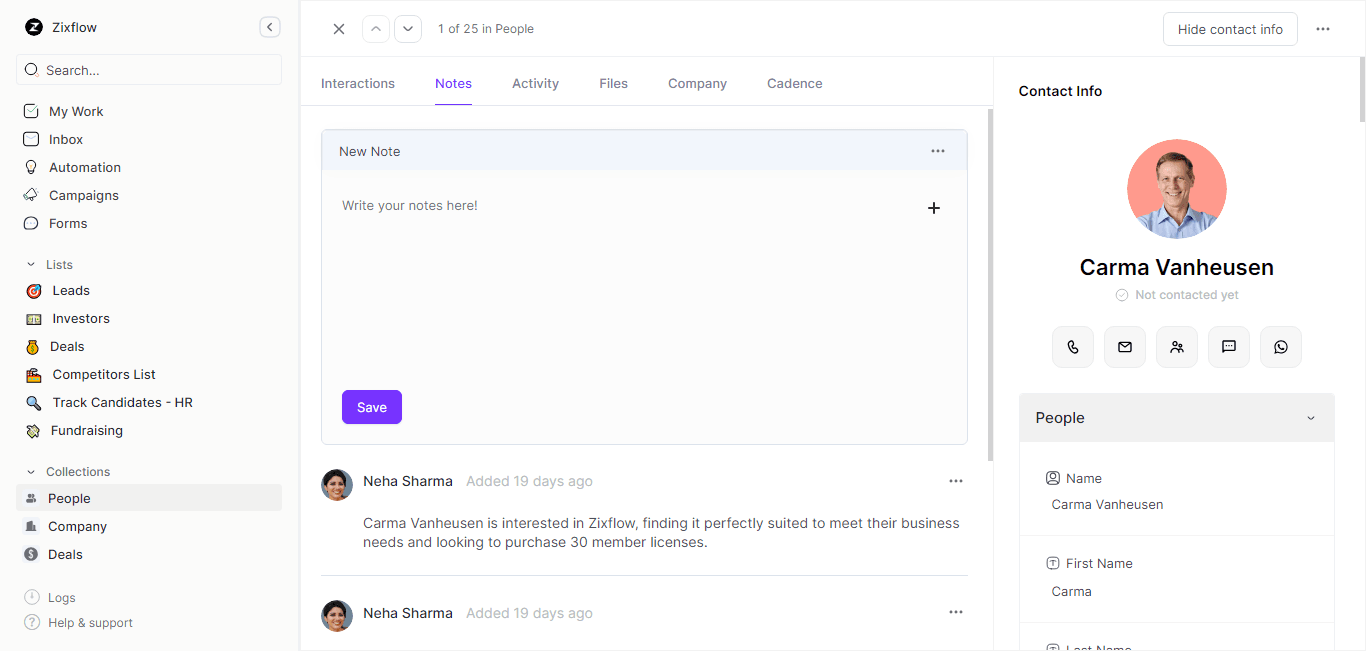
Furthermore, in Zixflow, you can set up sales cadences to automatically send first, second, or third follow-ups in case a prospect doesn’t respond repeatedly. If the prospect reaches out to you after the first follow-up, the cadence will automatically break and not send the next emails.
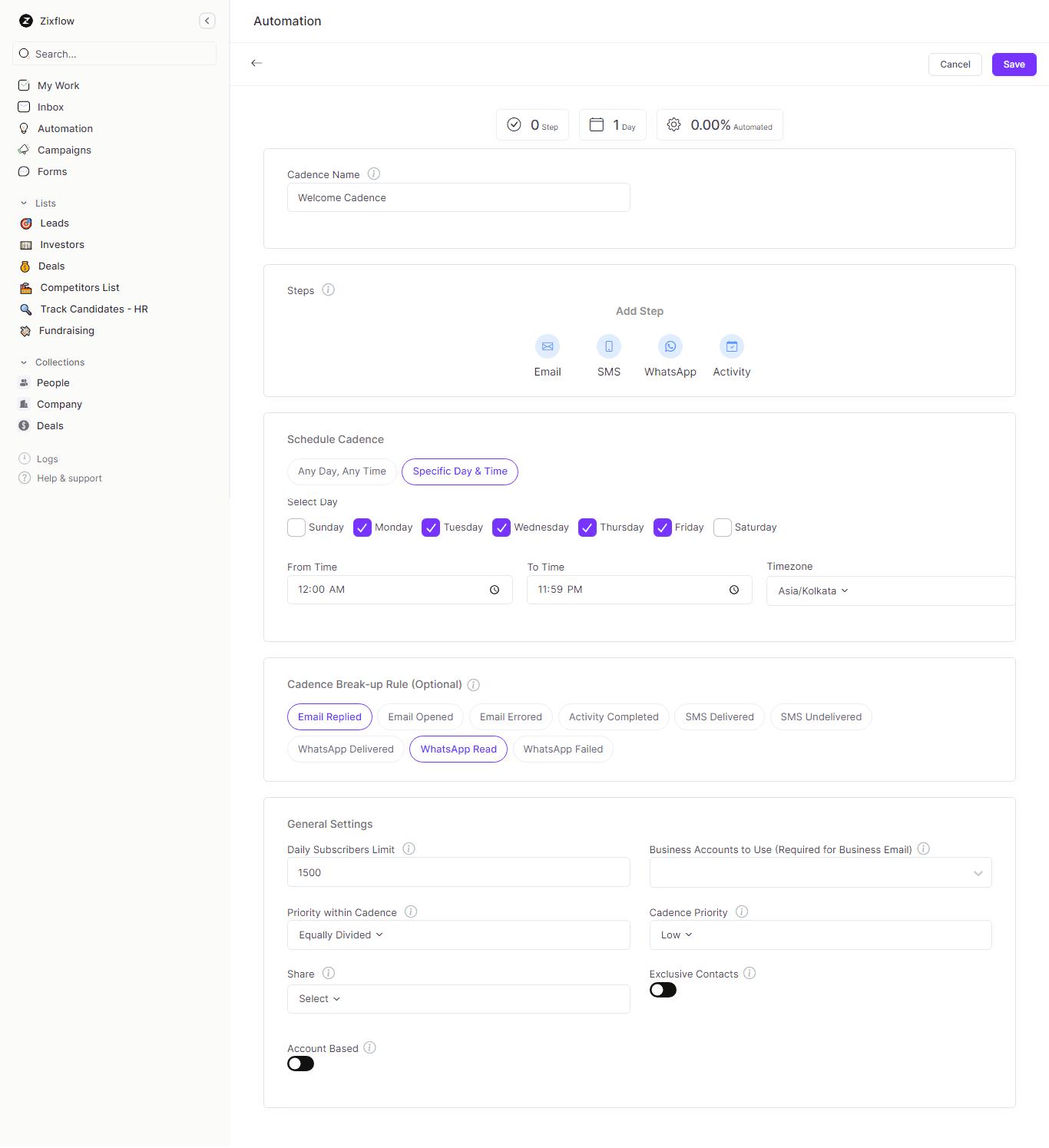
Adapt to feedback
We learn to improve ourselves by asking for suggestions or feedback from others. It allows us to be a better version of ourselves and perform our tasks much more efficiently. The same goes for creating sales pitches as well.
At the end of your sales pitch, if you can ask your audience for feedback or once they have converted, you can ask them, “How can you improve your sales pitch that would have instantly made them purchase your offerings?”
Customers are always happy to help you improve your process because they know they will be one benefitting from your optimized operations. Also, asking for feedback from your customers shows that you’re constantly trying to improve yourself to provide the best sales engagement experience to satisfy your customers.
Recommend other options
Even after giving your all, there might be cases where you will not be able to meet the requirements of your prospects or your solutions might not be a good match for them.
In that situation, instead of cutting off all communications, you can recommend to your prospects some other solutions and focus on building a good relationship with them. You can point them to relevant partners or your collaborators that you think could be a good fit for them.
It’s better to look forward to long-term goals if you're not able to convert a lead. And you can also benefit your partners by sending a warm lead their way, further strengthening your connections.
Create an amazing sales pitch with these practical tips
So, these are the actionable tips you can use to create an outstanding sales pitch that not only engages your audience but also generates revenue for your company.
A sales pitch is an important part of your business’s image. The more it aligns with your overall business goals, the more effective it will be at building meaningful relationships and bridging a steady stream of leads in your sales pipeline.
With that said, put these tips into action and craft a well-structured sales pitch that will knock your lead-generation efforts out of the park. And if you require a communication platform that allows you to contact prospects at every touchpoint of the sales process, then Zixflow is the best choice for you.
Get a personalized demo of the platform today.
